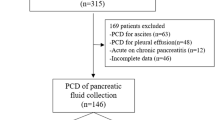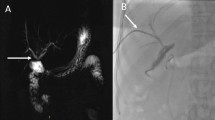Abstract
Objectives
To prospectively investigate the pre and intra-procedural risk factors for immediate (IF) and delayed-onset (DOF) fever development after percutaneous transhepatic biliary drainage (PTBD).
Methods
Institutional review board approval and informed patient consent were obtained. Between February 2013 and February 2014, 97 afebrile patients (77 at the Sapienza University of Rome, Italy and 20 at the Sun Yat-sen University of Guangzhou, China) with benign (n = 31) and malignant (n = 66) indications for a first PTBD were prospectively enrolled. Thirty pre- and intra-procedural clinical/radiological characteristics, including the amount of contrast media injected prior to PTBD placement, were collected in relation to the development of IF (within 24 h) or DOF (after 24 h). Fever was defined as ≥37.5 °C. Binary logistic regression analysis was used to assess independent associations with IF and DOF.
Results
Fourteen (14.4 %) patients developed IF and 17 (17.5 %) developed DOF. At multivariable analysis, IF was associated with pre-procedural absence of intrahepatic bile duct dilatation (OR 63.359; 95 % CI 2.658–1510.055; P = 0.010) and low INR (OR 4.7 × 10−4; 95 % CI 0.000–0.376; P = 0.025), while DOF was associated with unsatisfactory biliary drainage at the end of PTBD (OR 4.571; 95 % CI 1.161–17.992; P = 0.030).
Conclusions
The amount of contrast injected is not associated with post-PTBD fever development. Unsatisfactory biliary drainage at the end of PTBD is associated with DOF, suggesting that complete biliary tree decompression should be pursued within the first PTBD. Patients with unsatisfactory drainage and those with the absence of pre-procedural intrahepatic bile duct dilatation, which is associated with IF, require tailored post-PTBD management.



Similar content being viewed by others
Abbreviations
- PTBD:
-
Percutaneous transhepatic biliary drainage
- IR:
-
Interventional radiology
- IF:
-
Immediate fever
- DOF:
-
Delayed-onset fever
- ERCP:
-
Endoscopic retrograde cholangiopancreatography
- CT:
-
Computed tomography
- MR:
-
Magnetic resonance
- AST:
-
Aspartate aminotransferase
- ALT:
-
Alanine aminotransferase
- ALP:
-
Alkaline phosphatase
- GGT:
-
Gamma glutamyl transpeptidase
- WBC:
-
White blood cell
- INR:
-
Prothrombin time
- ECG:
-
Electrocardiography
- SpO2 :
-
Oxygen saturation
- NIBP:
-
Non-invasive blood pressure
References
Itoi T, Tsuyuguchi T, Takada T, et al. TG13 indications and techniques for biliary drainage in acute cholangitis (with videos). J Hepato-Biliary-Pancreat Sci. 2013;20(1):71–80.
Saad WE, Wallace MJ, Wojak JC, et al. Quality improvement guidelines for percutaneous transhepatic cholangiography, biliary drainage, and percutaneous cholecystostomy. Journal Vasc Interv Radiol. 2010;21(6):789–95.
Ahn S, Lee YS, Lim KS, et al. Malignant biliary obstructions: can we predict immediate postprocedural cholangitis after percutaneous biliary drainage? Suppor Care Cancer. 2013;21(8):2321–6.
Ginat D, Saad WE, Davies MG, et al. Incidence of cholangitis and sepsis associated with percutaneous transhepatic biliary drain cholangiography and exchange: a comparison between liver transplant and native liver patients. AJR Am J Roentgenol. 2011;196(1):W73–7.
Halpenny DF, Torreggiani WC. The infectious complications of interventional radiology based procedures in gastroenterology and hepatology. J Gastrointestin Liver Dis. 2011;20(1):71–5.
Weber A, Gaa J, Rosca B, et al. Complications of percutaneous transhepatic biliary drainage in patients with dilated and nondilated intrahepatic bile ducts. Eur J Radiol. 2009;72(3):412–7.
Ozden I, Tekant Y, Bilge O, et al. Endoscopic and radiologic interventions as the leading causes of severe cholangitis in a tertiary referral center. Am J Surg. 2005;189(6):702–6.
Rosch T, Triptrap A, Born P, et al. Bacteriobilia in percutaneous transhepatic biliary drainage: occurrence over time and clinical sequelae. A prospective observational study. Scand J Gastroenterol. 2003;38(11):1162–8.
Nomura T, Shirai Y, Hatakeyama K. Bacteribilia and cholangitis after percutaneous transhepatic biliary drainage for malignant biliary obstruction. Dig Dis Sci. 1999;44(3):542–6.
Yee AC, Ho CS. Percutaneous transhepatic biliary drainage: a review. Crit Rev Diagn Imaging. 1990;30(3):247–79.
de Jong EA, Moelker A, Leertouwer T, et al. Percutaneous transhepatic biliary drainage in patients with postsurgical bile leakage and nondilated intrahepatic bile ducts. Digestive Surg. 2013;30(4–6):444–50.
Link BC, Yekebas EF, Bogoevski D, et al. Percutaneous transhepatic cholangiodrainage as rescue therapy for symptomatic biliary leakage without biliary tract dilation after major surgery. J Gastrointest Surg. 2007;11(2):166–70.
Dondelinger RF, Adler OB. Interventional radiology. New York: Thieme Medical Publishers; 1990.
Kandarpa K. Handbook series handbook of interventional radiologic procedures. Philadelphia: Lippincott Williams & Wilkins; 2010.
Murakami Y. An experimental study on mechanism of regurgitation of the intrabiliary endotoxin into the blood stream in obstructive jaundice. Nihon Geka Gakkai Zasshi. 1992;93(11):1398–409.
Sakoda K, Furukawa T, Akita H. Pathophysiological aspect of the liver in acute obstructive suppurative cholangitis. Gastroenterologia Jpn. 1981;16(5):465–71.
World Medical Association Declaration of Helsinki: ethical principles for medical research involving human subjects. JAMA, 2000;284(23):3043–45.
Funaki B, Zaleski GX, Straus CA, et al. Percutaneous biliary drainage in patients with nondilated intrahepatic bile ducts. AJR Am J Roentgenol. 1999;173(6):1541–4.
Axelrod YK, Diringer MN. Temperature management in acute neurologic disorders. Neurol Clin. 2008;26(2):585–603.
Del Bene VE. Temperature. In: Walker HK, Hall WD, Hurst JW, editors. Clinical methods: the history, physical, and laboratory examinations. 3rd ed. Boston: Butterworths; 1990.
Laupland KB. Fever in the critically ill medical patient. Crit Care Med. 2009;37(7 Suppl):S273–8.
Chang WH, Kortan P, Haber GB. Outcome in patients with bifurcation tumors who undergo unilateral versus bilateral hepatic duct drainage. Gastrointest Endosc. 1998;47(5):354–62.
Author information
Authors and Affiliations
Corresponding author
Ethics declarations
Conflict of interest
For all authors, there is no potential conflict of interest that could be perceived to bias our work. Authors had full control of all the data and information presented in this manuscript.
Ethical Approval
All procedures performed in studies involving human participants were in accordance with the ethical standards of the institutional and/or national research committee and with the 1964 Helsinki declaration and its later amendments or comparable ethical standards.
Informed Consent
Informed consent was obtained from all individual participants included in the study.
Additional information
Pierleone Lucatelli and Stefano Ginanni Corradini have been contributed equally to this work.
Electronic supplementary material
Below is the link to the electronic supplementary material.
Rights and permissions
About this article
Cite this article
Lucatelli, P., Corradini, S.G., Corona, M. et al. Risk Factors for Immediate and Delayed-Onset Fever After Percutaneous Transhepatic Biliary Drainage. Cardiovasc Intervent Radiol 39, 746–755 (2016). https://doi.org/10.1007/s00270-015-1242-9
Received:
Accepted:
Published:
Issue Date:
DOI: https://doi.org/10.1007/s00270-015-1242-9




